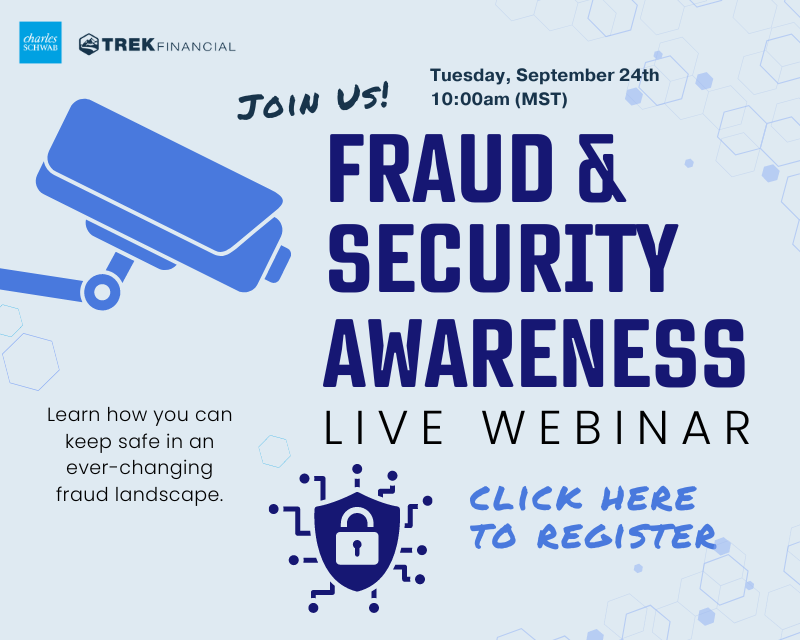
Retirement Does Not Have To Be Spooky Or Scary
Article written by Jann E. Freed, Forbes.com.
With October in full swing, many people are grabbing their favorite pumpkin-spiced drink and re-watching their favorite horror movies featuring ghouls, ghosts, and other creepy supernatural creatures. However, for many people, the spookiest and scariest things in life are closer to home.
Recently, Paul Long of New Way Forward wrote an article titled “Retirement Isn’t All It’s Cracked Up To Be (Actually, It’s Much Worse). He pointed out that on the Holmes & Rahe Stress Scale, at least 20 of the top 43 stress-producing life events often take place during our retirement years. And retirement itself is #10.
When you are not prepared for what’s next, retirement and aging can be a scary time of life.
So much of our life is scripted as if all stages are linear and planned out for us. Go to elementary school, followed by middle school, and high school. But even that is not so simple anymore. One of my friends said, “It was harder for me to get my son into elementary school than it was for me to get accepted into Stanford!” While she was exaggerating, she explained the competitive and extensive application process to get into a private elementary school in San Francisco.
For each life phase we are in, we usually need to think about and prepare for the next phase. Most of us did not wait until we were seniors in high school to start thinking about college. When we are in college, we start preparing for life after college. Then we begin our careers and learn how to navigate the workplace and where we want to go in our careers. But who helps us plan for what’s after our main career? This can often feel as if we are jumping off a diving board into unknown waters.
Moreover, many people don’t plan for the non-financial aspects of retirement, and before they know it, they feel in over their head. It doesn’t have to be that way.
Mindset Matters
The good news is that whether you’re approaching retirement or currently in retirement, there are some concrete actions you can take to make this time in your life less stressful. In fact, much of my work concerns helping people make the rest of life the best of life.
The Stanford Center of Longevity has developed a New Life Map to address this whole new life phase. The map embraces the Longevity Revolution to help us live a healthy, active, and purposeful life.
According to the Retirement Coaches Association, there is a trend of people being dissatisfied and unhappy in retirement due to: lack of fulfillment, lack of relevance, lack of purpose, and loss of identity. Notice that the trends focus on what is missing and not what can be gained while being in retirement.
Dr. Becca Levy, a psychologist at Yale University, has research that indicates that we live healthier and longer –on average 7.5 years longer —if we live life with a positive mindset. She says this mindset is more impactful than stopping smoking or starting to exercise.
So how do we change our mindset about aging and retirement? An article from the New York Times in 2023 where Dr. Levy described some key actions to take.
- Notice from where your beliefs about age and retirement come. To change our beliefs, we must be aware of them. Society doesn’t make aging and retirement easy. The next time you buy a birthday or retirement card, pay attention to the messages. Many of the messages are negative while attempting to be humorous.
- Seek out role models. Dr. Levy recommends identifying at least five people who are aging and living their time in retirement that you find attractive. What are they doing that appeals to you?
- Don’t mistake forced positivity for optimism. Research indicates “optimistic women are more likely to live past 90 than less optimistic women, regardless of race or ethnicity.” This is not about thinking happy thoughts, but Levy says we need to “look at the honest reality with optimism.” We may not be able to do what we have done in the past, but the wisdom we gain from life experience can be more valuable than being able to physically do what we did when we were younger.
- Challenge your fears about getting older. Reflect on your worries about the aging process. Try not to jump to conclusions. Question your assumptions. Push back on our youth-centric society and the stereotypes associated with younger is better and older is invisible.
- Remind yourself of the benefits of aging and retirement. Focus on what you’re gaining, too. There are benefits from the flexibility and freedom that comes with retirement. Levy’s research has shown that “emotional well-being generally increases with age, and certain aspects of cognition, like conflict resolution, often improve in later life.”
Changing one’s mindset about aging and retirement is not easy. When we make decisions with intention and prepare in advance for the next phase of life, retirement doesn’t have to be spooky and scary. With a positive mindset about aging and retirement, we can see the benefits and make the rest of life the best of life.
Navigate The Changes To Medicare in 2025
Article written by Elizabeth Guevara, Investopedia
In 2025, Medicare will undergo some of the most significant changes since its inception in 2006.
These changes are mostly the result of the Inflation Reduction Act and will set the amount of out-of-pocket drug spending to $2,000, add an opt-in payment plan, and include other, broader changes to Medicare Advantage plans.
Investopedia spoke with Jennifer Teague, director for health coverage and benefits for the National Council on Aging, about how Medicare beneficiaries should prepare for their health care plan changes. The interview has been edited for brevity and clarity.
INVESTOPEDIA: What should Medicare beneficiaries be aware of before enrolling in Medicare for next year?
JENNIFER TEAGUE: Every year, through open enrollment, we encourage and remind Medicare beneficiaries to review their drug plans and their Medicare Advantage plans.
Each year, the formulary for what medications are covered, what physicians are in network, etc, can change. That open enrollment period from Oct. 15 to Dec. 7 is the only time that many Medicare beneficiaries have to make changes to their coverage for the following year.
INVESTOPEDIA: What are some of the most important changes coming for Medicare that beneficiaries should be aware of?
JENNIFER TEAGUE: One of the biggest changes that people are starting to talk about is the $2,000 cap that’s going to be out-of-pocket for Medicare beneficiaries who are receiving their prescriptions through a Medicare drug plan. The donut hole will no longer be in effect come January 1, and so the max out-of-pocket that a Medicare beneficiary will pay for their prescription drugs that are on the formulary plan that they enrolled in will be $2,000 for their copay.
There’s also something that’s called the Medicare Prescription payment plan, which will allow Medicare beneficiaries the opportunity to spread the $2,000 cost out over the year if they should so choose. Every Medicare beneficiary will be provided the opportunity to enroll in that benefit, and it will be aligned with every drug plan, but not every beneficiary has to enroll in that.
INVESTOPEDIA: What problems do you see arising from the many changes coming next year? What can people do to prepare for enrolling in Medicare on Oct. 15?
JENNIFER TEAGUE: I think that there’s a possibility for confusion around the $2,000 out-of-pocket max and the ability to spread that over the course of the year. That’s a new option that individuals have not had historically, and that may lead to some confusion.
The first thing I would encourage people to do is put together a list of the medications that they take, the name, the milligram, and the frequency. Then schedule an appointment with a State Health Insurance Assistance Program (SHIP) counselor to review the plan options and make the decision of what’s best for the following year.
I would add that individuals are always encouraged to see if they qualify for the extra health benefits from the Medicare Savings Program, which can help them reduce the cost of their prescription drugs and also their Medicare premium.


Three Major Estate Plan Mistakes to Avoid
Article written by Jay Dorso, Kiplinger.com
A complete and up-to-date estate plan can help ease your loved ones’ worries and make things easier for them after you pass.
An estate plan helps designate who will receive your assets in the event of your death. Despite many thinking an estate plan is only for the rich, everyone can benefit from having one.
While important, an estate plan can be a difficult document to create, leading to potential mistakes that can cost you or your loved ones a lot of money. Estate planning errors can drastically hurt the financial legacy you want to leave behind. Here are some of the big ones:
1. Not having an estate plan
The first, and perhaps biggest mistake you can make with estate planning is not doing it. After you pass, those closest to you are left dealing with the shock and grief, and you don’t want to burden them with added financial issues. Having an estate plan in place can give them peace of mind and provide clear guidance for handling your affairs.
If creating an estate plan is on your to-do list, don’t procrastinate! Many people think they have plenty of time to create one — someone who is 35 years old may think they have decades to get things in order, but delaying can create extra risk for your family. The truth is, no matter your age, anything can happen. If you pass away and you still have young children, who will be their legal guardian? Without a will or an estate plan, you are putting your children’s future at risk. What if you pass away unexpectedly? Or what happens if you become incapacitated, and no one is assigned to make medical decisions on your behalf?
2. Not asking for help with your estate plan
Another common estate planning mistake I see is when people try to do everything on their own. Estate plans that contain mistakes can cause many complications after you pass. No matter the size of your estate, there are still assets to be passed on to your family.
Working with an expert, such as a financial adviser, who has the skills to put together and manage estate plans, can help avoid those errors. An adviser can educate you on what documents you need in your plan such as wills, powers of attorney and health care directives.
A financial adviser can help you inventory your assets and help ensure they are going to the right person. Your adviser can help you review all of your various retirement accounts and designate the exact amount you want to go to each of your beneficiaries.
3. Forgetting to regularly update your estate plan
Establishing an estate plan is an important step, but you can’t simply set it and forget it. Many life events will require you to take another look at it. Maybe you were divorced years ago, but your living will still lists your ex-spouse as the one entrusted to make your healthcare decisions.
What if you got remarried after your divorce? Have you changed the beneficiary of your 401(k) to your new spouse? You don’t want to pass away and subject your current spouse in legal battles with your ex.
The rule of thumb is if you get divorced or remarried, everything in your plan that has a beneficiary designation needs to be reviewed or changed.
It is not only a major life event like a divorce that may require changes to your estate plan. Failing to review and revise your estate plan after the birth of a child, the death of your primary beneficiary, starting a new business or buying a home can lead to big consequences, potentially distributing your assets to the wrong person.
Your financial advisor can help you organize a plan to ensure your assets are appropriately allocated and your family is taken care of.
How to Budget for a Vacation When Prices Keep Rising
Article written by Becca van Sambeck, Kiplinger.com
These vacation budgeting tips mean rising costs won’t keep you from going on a trip.
Everybody deserves a vacation, but with the eye-popping prices caused by inflation and travel demand, it doesn’t always feel feasible to have one. Fortunately, prices have pulled back a little as the rate of inflation has slowed down. Domestic airfare dropped 1.3% from August 2023 to 2024, according to the latest Consumer Price Index data. Car rental prices are also lower — down 8.4%. However, hotel prices have slightly risen over the past year (up 1.8%), according to NerdWallet.
Slowing inflation is good news, but it doesn’t wipe out the increases that are now baked into prices. However, don’t let trip costs make you feel like you have to throw in the towel. There are ways to properly budget for your vacation and go on the trip you’ve been dreaming of. It just requires a little flexibility, some time and a lot of planning.
Don’t let high prices keep you from going on a trip. Use these budgeting tips to plan a vacation even when prices are high.
Plan your trip early
If you’ve ever had to book a last-minute flight, you know prices soar the closer you are to the departure date. Your best bet to get a good deal — whether it’s on lodgings or transportation — is to book as early as you can.
According to Expedia’s 2024 travel hacks, you should book a domestic flight no later than 28 days before your departure to avoid big price hikes. When traveling internationally, reserve your seat at least three months before your trip.
Another perk for the early bird: The sooner you start planning, the sooner you can start setting aside money each month to fund your vacation.
Be flexible
Often, we have our heart set on a particular destination when dreaming of a vacation, but if you can be flexible with location, do it.
For example, domestic flights are often more affordable than international ones, and you can find beaches in the United States that are just as gorgeous as the ones in the south of France. The beaches in Alabama, for example, boast incredible white sand that makes for a picturesque scene, and you’ll find plenty of incredible Airbnbs and hotel rooms for a lower cost.
On the other hand, you may find lodging or activities are cheaper when you do decide to depart the U.S. If you head to a country in Central America, your dollar will go further than it would in Florida: You’ll find accommodations, meals, and other activities for a lesser price point than stateside.
Do your research as you decide where to go for vacation, and make sure to consider the costs and benefits of similar alternatives before you settle on the perfect spot.
Consider the outdoors
When most people travel, it’s to see beautiful sights and relax. An ultra-affordable way to do that? Go camping.
Opting for the great outdoors doesn’t mean you have to forgo modern conveniences. Rent camping equipment such as thick sleeping pads to make your tent even more comfortable, or check the price of renting an RV or a cabin. It’s a cost-effective way to enjoy the natural splendors the world has to offer.
Determine what you’re comfortable cutting
Ideally, vacation would mean going out for meals every night, trying every activity possible, and shopping at any store you see. In reality, you’re probably on a budget, so you’ll need to consider what you value most on this trip.
If dining isn’t the main objective of your trip, buy groceries so you can cook food in your accommodations. You can also limit the number of excursions to afford the ones you’re most excited about. Opt for a walkable destination or someplace with good public transportation to avoid pricey add-ons like renting a car.
There are always small cuts you can make to reduce the amount you’re spending while on vacation.
Travel in groups
Some vacations are arguably better as a party. Consider inviting friends or family to travel with you and split the costs.
Keep an eye out for discounts
Groupon is a great option for booking discounted activities at your vacation site, and some of the best travel websites and apps regularly offer excellent hotel deals. As you bargain hunt, make sure to do your research and use trusted vendors. If a deal sounds too good to be true, it likely is.

According to SHRM, a 2021 Employee Benefits Survey conducted by XPertHR showed that roughly 82% of employers studied matched a portion of their employees’ contributions while the remaining 18% didn’t provide any matches at all.
Source: shrm.org, 2021
Entertainment & Education
Looking for something to read?
This list consists of the top 7 retirement books of 2024.
Source: Morningstar.com
On the Bright Side
Updated Retirement INsights Disclosure: This document is for informational purposes only. All information is assumed to be correct but the accuracy has not been confirmed and therefore is not guaranteed to be correct. Information is obtained from third party sources that may or may not be verified. The information presented should not be used in making any investment decisions. It is not a recommendation to buy, sell, implement, or change any securities or investment strategy, function, or process. Any financial and/or investment decision should be made only after considerable research, consideration, and involvement with an experienced professional engaged for the specific purpose. All comments and discussion presented are purely based on opinion and assumptions, not fact. These assumptions may or may not be correct based on foreseen and unforeseen events. Past performance is not an indication of future performance. Any financial and/or investment decision may incur losses.
Investment Advisory Services offered through Trek Financial LLC, an investment adviser registered with the Securities Exchange Commission. Information presented is for educational purposes only. It should not be considered specific investment advice, does not take into consideration your specific situation, and does not intend to make an offer or solicitation for the sale or purchase of any securities or investment strategies. Investments involve risk and are not guaranteed, and past performance is no guarantee of future results. For specific tax advice on any strategy, consult with a qualified tax professional before implementing any strategy discussed herein.


